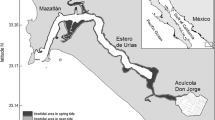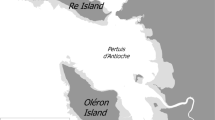Abstract
Animals may alter their foraging behaviour in the presence of humans because they perceive humans as potential predators. In this study I determined whether people caused shorebirds to reduce feeding rates at a stopover site in coastal British Columbia, Canada. I controlled for prey density and flock size because these variables may influence both the foraging rates as well as the effect of human disturbance on feeding efficiency. Semipalmated plovers decreased feeding rates when there were more people on the beach (multiple regression: F1,15=5.86, b=0.59, P=0.029, R2=37.6%). For least sandpipers, the effect of human densities on feeding rates depended on flock size (F1,21=5.97, P=0.023) and amphipod availability (F1,21=4.98, P=0.037). This study demonstrated the importance of measuring subtle behavioural changes in foraging rates along with key ecological variables in order to assess the true impact of human disturbance on migratory shorebirds.


Similar content being viewed by others
References
Barnard CJ (1980) Flock feeding and time budget in the house sparrow (Passer domesticus L.). Anim Behav 28:295–309
Burger J (1981) The effect of human activity on birds at a coastal bay. Biol Conserv 21:231–241
Burger J, Gochfeld M (1991) Human activity influence and diurnal and nocturnal foraging of sanderlings (Calidris alba). Condor 93:259–265
Colwell MA, Landrum SL (1993) Nonrandom shorebird distribution and fine-scale variation in prey abundance. Condor 95:94–103
Cooper JM (1994) Least Sandpiper No. 115. In: Poole CA, Gills F (eds) Academy of Natural Sciences, Philadelphia
Cresswell W (1994) Flocking as an effective anti-predation strategy in redshanks, Tringa totanus. Anim Behav 47:433–442
Davidson NC, Clark NA (1985) The effect of severe weather in January and February 1985 on waders in Britain. Wader Study Group Bull 44:10–16
Dodd SL, Colwell MA (1996) Seasonal variation in nocturnal and diurnal distributions of non-breeding shorebirds at North Humboldt Bay, California. Condor 98:196–207
Dolah RFV (1978) Factors regulating the distribution and population dynamics of the amphipod Gammarus palustris in an intertidal salt marsh community. Ecol Monogr 48:191–217
Duffy DC, Atkins N, Schneider D (1981) Do shorebirds compete on their wintering grounds? Auk 98:215–229
Elgar MA (1988) Predator vigilance and group size in mammals and birds: a critical review of the empirical evidence. Biol Rev 64:13–33
Ens BJ, Goss-Custard JD (1984) Interference among oystercatchers Haematopus ostralegus feeding on mussels Mytilus edulis on the Exe Estuary. J Anim Ecol 53:217–231
Fitzpatrick S, Bouchez B (1998) Effects of recreational disturbance on the foraging behaviour of waders on a rocky beach. Bird Study 45:157–171
Frid A, Dill L (2002) Human-caused disturbance stimuli as a form of predation risk. Conserv Ecol 6:11–26
Gill JA, Norris K, Sutherland WJ (2001a) The effect of disturbance on habitat use by black-tailed godwits Limosa limosa. J Appl Ecol 38:846–856
Gill JA, Norris K, Sutherland WJ (2001b) Why behavioural responses may not reflect the population consequences of human disturbance. Biol Conserv 97:265–268
Goss-Custard JD (1969) The winter feeding ecology of the redshanks Tringa totanus. Ibis 111:338–356
Goss-Custard JD (1970) Feeding dispersion in some overwintering wading birds. In: Crook JH (ed) Social behaviour in birds and mammals. Academic Press, NY, pp 3–35
Goss-Custard JD (1980) Competition for food and interference among waders. Ardea 68:31–52
Goss-Custard JD (1981) Feeding behaviour of redshanks, Tringa totanus and optimal foraging theory. In: Kamil AC, Sargent TD (ed) Foraging behaviour: ecological, ethological, psychological approaches. Garland, London, pp 115–133
Goss-Custard JD, Verboven N (1993) Disturbance of feeding shorebirds in the Exe Estuary. Wader Study Group Bull 68:59–66
Hair JF, Anderson RE, Tatham RL, Black WC (1998) Multivariate data analysis. Prentice-Hall, NY
Hill D, Hockin D, Price D, Tucker G, Morris R, Treweek J (1997) Bird disturbance: improving the quality and utility of disturbance research. J Appl Ecol 34:275–288
Hilton GM, Cresswell W, Ruxton GD (1999) Intra-flock variation in the speed of response on attack by an avian predator. Behav Ecol 10:391–395
Krebs JR, Davies NB (1987). An introduction to behavioural ecology. Blackwell Science, Oxford
Lima SL (1998) Stress and decision making under the risk of predation: recent developments from behavioral, reproductive, and ecological perspectives. Adv Study Behav 27:215–290
Lima SL, Dill LM (1990) Behavioural decisions made under the risk of predation: a review and prospectus. Can J Zool 68:619–640
Madsen J (1998) Experimental refuges for migratory waterfowl in Danish wetlands. I. Baseline assessment of the disturbance effects of recreational activities. J Appl Ecol 35:386–397
McNeil R (1991) Nocturnality in shorebirds. Proc Int Ornithol Congr, 103:598–620
Mitchell JR, Moser ME, Kirby JS (1989) Declines in midwinter counts of waders roosting on the Dee Estuary. Bird Study 35:191–198
Mori Y, Sodhi NS, Kawanishi S, Yamagishi S (2001) The effect of human disturbance and flock composition on the flight distances of waterfowl species. J Ethol 19:115–119
Moskoff W, Montgomerie R (2001) Baird’s Sandpiper No. 661. In: Poole CA, Gills F (eds) Academy of natural sciences, Philadelphia
Nol E, Blanken MS (1999) Semipalmated Plover No. 444. In: Poole CA, Gills F (eds) Academy of natural sciences, Philadelphia
Pfister C, Harrington BA, Lavine M (1992) The impact of human disturbance on shorebirds at a migration staging area. Biol Conserv 60:115–126
Pfister C, Kasprzyk MJ, Harrington BA (1998) Body-fat levels and annual return in migrating semipalmated sandpipers. Auk 115:904–915
Rodgers JA Jr, Schwikert ST (2002) Buffer-zone distances to protect foraging and loafing waterbirds from disturbance by personal watercraft and outboard-powered boats. Conserv Biol 16:216–224
Rojas LM, McNeil R, Cabana T, Lachapelle P (1999) Diurnal and nocturnal visual capabilities in shorebirds as a function of their feeding strategies. Brain Behav Evol 53:29–43
Schneider D, Harrington BA (1981) Timing of shorebird migration in relation to prey depletion. Auk 98:801–811
Stillman RA, Goss-Custard JD (2002) Seasonal changes in the response of oystercatchers Haematopus ostralegus to human disturbance. J Avian Biol 33:358–365
Stillman RA, Goss-Custard JD, Clarke RT, Durell SEA le V dit (1996) Shape of the interference function in a foraging vertebrate. J Anim Ecol 65:813–824
Thomas K, Kvitek RG, Bretz C (2003) Effects of human activity on the foraging behaviour of sanderlings Calidris alba. Biol Conserv 109:67–71
Triplet P, Stillman RA, Goss-Custard JD (1999) Prey abundance and the strength of interference in a foraging shorebird. J Anim Ecol 68:254–265
Turpie J, Hockey PAR (1993) Comparative diurnal and nocturnal foraging behaviour and energy intake of premigratory grey plovers Pluvialis squatarola and whimbrels Numenius phaeopus in South Africa. Ibis 135:156–165
Williams JA (1995) Burrow-zone distribution of the supralittoral amphipod Talitrus saltator on Derbyhaven Beach Isle-of-Man—a possible mechanism for regulating desiccation stress. J Crustacean Biol 15:466–475
Yates MG, Stillman RA, Goss-Custard JD (2000) Contrasting interference functions and foraging dispersion in two species of shorebird (Charadrii). J Anim Ecol 69:314–322
Ydenberg RC, Butler RW, Lank DB, Smith BD, Ireland J (2004) Western sandpipers have altered migration tactics as peregrine populations have recovered. Proc R Soc Lond Ser B Biol Sci 271:1263–1269
Acknowledgements
Thanks to Alan Burger, Peter Hodum, Natalie Hamel, Rob Butler, Phil Dearden, Dave Duffus, John Quinn, Will Cresswell, Charlie Short, Trevor Haynes, Jessica Beaubier, Johannes Ebeling and anonymous referees for valuable suggestions on methods and comments on previous drafts. I also thank the staff at Bamfield Marine Station and Philip Dearden for equipment, Ole Heggen for maps and Natalie Hamel, Rian Dickson, Christine Dahl, Omar McDadi, Nikki Stubbs and Johannes Ebeling for invertebrate sampling. I was supported by a PGS-A scholarship from NSERC, Canada.
Author information
Authors and Affiliations
Corresponding author
About this article
Cite this article
Yasué, M. The effects of human presence, flock size and prey density on shorebird foraging rates. J Ethol 23, 199–204 (2005). https://doi.org/10.1007/s10164-005-0152-8
Received:
Accepted:
Published:
Issue Date:
DOI: https://doi.org/10.1007/s10164-005-0152-8




